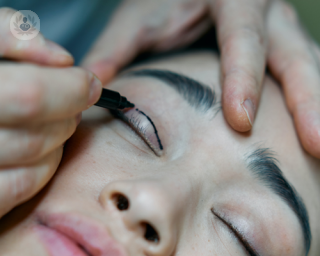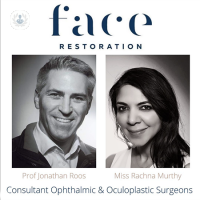Eyelid cancer
Professor Jonathan Roos - Ophthalmology
Created on: 03-11-2020
Updated on: 04-26-2023
Edited by: Sophie Kennedy
What is eyelid cancer?
Eyelid cancer is a tumour that affects either the skin or glands of the eyelid. Most eyelid cancers are recognised as skin cancer. Your eyelid skin is the thinnest and most sensitive area of skin on your body that can get damaged easily by too much sun exposure.
The most common type of eyelid cancer is known as basal cell carcinomas: a slow-growing cancer that typically doesn’t spread to other parts of the body. Less common types are squamous cell and sebaceous gland carcinomas and malignant melanoma, which often account for around ten per cent of cases. These types of skin cancers are more aggressive and can spread to nearby lymph nodes and other areas of the body.

What are the signs and symptoms?
Signs and symptoms of eyelid cancer appear on the eyelid skin and can include:
- A painless, reddish growth that is smooth, shiny and firm
- A sore that bleeds or develops a scab
- A rough, brown or red patch
- A flat brown or flesh-coloured like lesion that has a scaly texture
- A sty that doesn’t go away
- An itchy flat spot with a dry, crusted surface
- Loss of eyelashes
What causes eyelid cancer?
Cancer begins when cells change and grow uncontrollably, resulting in a tumour. One of the main causes of this in eyelid cancer is excessive exposure to ultraviolet (UV) radiation from the sun or other sources such as tanning beds.
Too much exposure to UV rays damage the DNA of skin cells which triggers a cell to grow out of control. As the eyelid is the most sensitive and thinnest skin surface on the body, it is very susceptible to this kind of damage.
How is eyelid cancer diagnosed?
An ophthalmologist will closely and carefully examine the eyelid abnormality and take a biopsy to confirm the diagnosis.
If the doctor suspects that cancer has spread to other areas of the body, they may request that you undergo additional imaging and diagnostic tests such as a CT scan, MRI scan or sentinel lymph node biopsy.
How is eyelid cancer treated?
The treatment for eyelid cancer depends on its nature and progression.
The main treatment is to remove the tumour and a small margin of the surrounding tissue. This may be followed by reconstructive surgery to repair the damaged area and help improve the function of the eyelid.
Other treatment options include radiotherapy, topical chemotherapy drops or creams, or cryotherapy.
If the form of cancer is particularly aggressive or advanced, you may have to undergo chemotherapy, immunotherapy, radiotherapy or certain targeted medications.
Detecting eyelid cancer early is extremely important in preventing the cancer from spreading to other parts of your body.
Who is at risk of eyelid cancer?
Certain people are at a higher risk of developing eyelid cancer. These include:
- People that live in a place with year-round, bright sunlight
- Those who spend a lot of their time outdoors
- People that regularly use tanning beds
- People with fair, pale or freckled skin
How can eyelid cancer be prevented?
The most effective way to prevent eyelid cancer is to protect the eyes from UV rays when outdoors. This involves wearing a hat with a long or wide brim, applying SPF 30+ sun cream, and wearing UV-blocking sunglasses.
To catch eyelid cancer early, it is important to become accustomed to how your eyelids and area around your eyes look normally, so you can easily identify any changes.
Which specialist diagnoses and treats eyelid cancer?
Both an ophthalmologist or a dermatologist can typically diagnose and treat patients with eyelid cancer.










